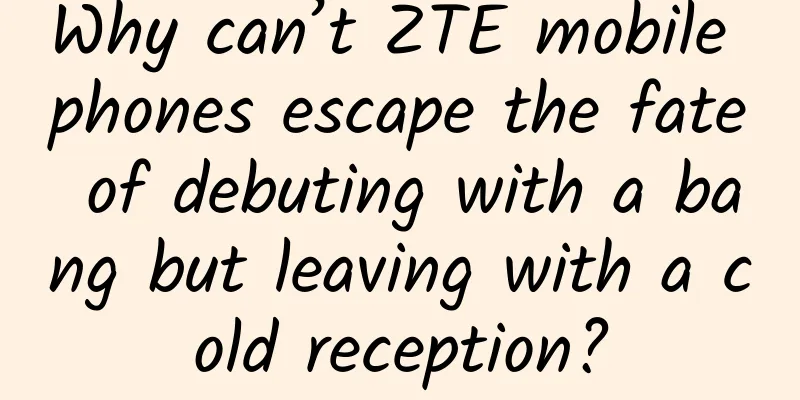Why can’t ZTE mobile phones escape the fate of debuting with a bang but leaving with a cold reception?

|
After several years of hype, just when we thought that Xiaomi, Huawei and other first-tier mobile phone brands would be the first to launch under-screen camera phones, a "small factory" took the lead and amazed the whole world. Earlier this month, ZTE released the world's first under-screen camera phone - Axon 20. Considering that since 2016, when the technology was not mature, the smartphone industry has begun to approach the ultimate goal of "full screen" through designs such as water drop screen, notch screen, and hole screen. Now, when ZTE Axon 20 realizes the true "full screen" form for the first time, and the price is very affordable, the market has not moved at all. Only 100 pre-sale reviews reveal the huge pressure faced by ZTE mobile phones. ZTE Mobile: Always getting up early and always catching up late In the history of mobile phone development, ZTE is actually a brand that is very good at creating the "world's first". ZTE has always been very far-sighted in judging the development direction of the smartphone industry. However, ZTE often sees opportunities to seize the market, but cannot escape the fate of leaving the market in disgrace again and again. In 2015, when the industry was still obsessed with specs and configurations, ZTE realized the need to find high-dimensional functions to attract users, so it released the nubia Z5 mini, which focuses on photography. Ni Fei, then general manager of nubia, once said: "nubia Z5 mini uses a 13-megapixel Konica-Minolta professional main lens, and the photography experience is its biggest selling point." A year later, Huawei launched the Leica co-branded phone P9 for the first time, redefining mobile phone photography, while the nubia phone co-branded with Konica Minolta has long been forgotten by the public. In 2018, as the homogeneity problems of appearance, configuration, etc. became more and more serious, many smartphones began to work hard on photography. For example, the Huawei P20 Pro scored 109 points on the DxOMark website that year, becoming the photography artifact of the year and establishing Huawei's dominance in photography in the mobile phone industry. In 2019, the most popular mobile phone category is undoubtedly foldable phones. According to Strategy Analytics data, global shipments of foldable phones reached 1 million units in 2019. I believe that if there are no production capacity constraints, this number will further increase. However, ZTE actually released the foldable phone AXON M as early as 2017. However, due to various reasons, the reputation of this product was limited to the circulation among players and did not win the recognition of more consumers. Many people think that Huawei Mate 20X 5G is China's first commercial 5G phone, but the first 5G phone to be released to consumers is from ZTE. In August 2019, ZTE Axon 10 Pro 5G was officially launched. It was only two months after the 5G commercial license was officially issued, which shows ZTE's strong technical reserves and rapid strategic layout. Getting up early, but arriving late. In wave after wave, ZTE mobile phones, which have bet on almost all technological trends, have become the front wave without exception. This is also reflected in the market level, with no product becoming a hit, and almost all of them have failed without causing any waves. What went wrong with ZTE? The answer to this question also implies the fate of the ZTE Axon 20, the world's first under-screen camera phone. AXON 20 also cannot escape the fate of sinking 2012 was the peak period for ZTE mobile phones. According to IDC data, ZTE shipped 65 million mobile phones in 2012, accounting for 3.8% of the global market share, ranking fourth, ahead of Huawei. As a result, the market got the title of "China Cool Alliance". After the peak, ZTE's mobile phone market performance has gradually declined. TrendForce data shows that in 2014, ZTE's mobile phone shipments fell from fourth to tenth in the world. In 2019, ZTE's mobile phones, which continued to decline, no longer appeared alone in the list of market analysis agencies, but were replaced by the "other" category. Admittedly, the steep decline in ZTE's mobile phone sales is related to the policy ban in 2016, which caused ZTE to lose its overseas market. However, it cannot be ignored that Huawei also suffered a ban and lost its overseas market in 2018, but in 2019, Huawei's mobile phone shipments still grew by 16.8% year-on-year. This is enough to prove that the subjective power of manufacturers can reverse objective restrictions. Obviously, the problem lies within ZTE. How to change all this? Nubia President Ni Fei was recently promoted to General Manager of ZTE's Terminal Business Unit, which is a positive signal of internal change. It is worth noting that in the process of continuous decline, ZTE also tried hard to reverse the decline. From the perspective of channels and products, it can be found that ZTE's fall behind is mainly distributed in two stages. 1. The operator is the key to your success and failure. Until 2016, 90% of ZTE's mobile phone shipments were dependent on operators, while the open market channel accounted for only 10%. It is well known that e-commerce and offline channels have become the main market players since 2013. In this channel transformation, Huawei, which was as famous as ZTE at the time, achieved impressive market data in one fell swoop due to its timely development of non-operator channels. Its Internet brand Honor became the number one online mobile phone brand in China in Q1 2019, occupying 24% of the market share. Of course, faced with the general trend of channels shifting to online, ZTE has not been idle. It has strengthened its Internet sales genes by launching the online brand nubia. 2. Lack of extreme product strategy for bucket machines ZTE has been making market layout by betting on cutting-edge technologies and has led the direction of the industry several times. However, the market has not given corresponding positive feedback to this cutting-edge technology. The main reason is that ZTE often overemphasizes a certain technology and ignores the overall experience of the phone. As Peter Drucker's famous bucket theory says, "How much water a bucket can hold does not depend on the highest piece of wood on the wall of the bucket, but only on the shortest piece." Take the first 5G commercial mobile phone ZTE Axon 10 Pro 5G as an example. It focuses on building 5G networks, but is only equipped with the mid-range camera sensor Samsung GM1 and a low-end 1080P display panel. As a result, this product, which should have been a hit, wasted its huge first-mover advantage and quickly fell from user reputation because of its two major shortcomings in camera and display. More importantly, although ZTE Mobile has seen the market trend, its product innovation has not been thorough. Take the foldable mobile phone ZTE AXON M as an example. Although its appearance is similar to the folding screen mobile phone in 2019, it simply and crudely splices two screens together. It has a false reputation but no substance, leaving consumers with a bad impression that it does not live up to its reputation. If we look deeper, the defects of ZTE mobile phones reveal the various "empty ideas" that ZTE has developed due to its long-term immersion in operator channels. Specifically, in terms of technology, it takes grabbing topics and false reputation as its own responsibility, and ignores the actual needs of users. As a result, it has launched a lot of short-board products that operators cannot sell and consumers do not buy. According to ZTE's public information, although it started out as a communications company, in 2019, its business also covered many new areas that have nothing to do with communications, such as real estate and new energy vehicles. As a result, ZTE, a state-owned enterprise, invested only 12.5 billion yuan in research and development that year. On the other hand, Huawei has always focused on the communications field, with communications and mobile phones as its core, and has expanded outward to create a variety of technologies with great commercial potential, such as Hongmeng, Kirin, and Kunpeng. In 2019, Huawei's R&D investment reached 131.7 billion yuan, ten times that of ZTE. Now, let's look back at ZTE's "world's first under-screen camera phone" AXON 20. Through the configuration specifications, we can easily find that this product is actually the same as AXON M, Axon 10 Pro 5G and other products in concept - use the concept to seize the initiative, sell as many as you can, and as for whether users will curse you in the future, it's just like what King Louis XV said: After I die, I don't care about the flood. According to the information exposed on the Internet, as the supply chain technology matures, many mobile phone manufacturers including Xiaomi and vivo will launch their own under-screen camera phones by the end of this year. In other words, the reason why ZTE grabbed the first launch is just because it "dared" to be the first. Just like premature babies are often not very healthy. We can also see in many reviews that ZTE Axon 20 is not perfect, and it can even be said to be immature. The under-screen camera on the top is looming, and it is not beautiful and easy to use. In order to control costs, the processor only uses the mid-range Snapdragon 765G processor. This approach is very similar to the Motorola, a declining mobile phone brand that has been transferred to Lenovo - it hardly uses top-level chips, but it will definitely catch people's attention in some aspects. But what's the use of this? Don't consumers have the ability to distinguish? From the industry's perspective, ZTE mobile phones have been desperately chasing the trend and constantly launching products with great gimmicks, but these products are often not perfect and the product experience is also unsatisfactory. As the supply chain matures, once comprehensive and balanced products are fully launched, it basically means the death of ZTE's related products. Combined with the many cutting-edge products in ZTE's history, ZTE mobile phones have fallen into such a vicious cycle. If you don't believe it, just look at the Alpha watch phone that Nubia pioneered in the industry. The flexible screen, watch shape, and various designs all highlight its pioneering positioning. However, more than a year after its launch, there are only a few hundred customer reviews, and the price has also fallen from a high of nearly 5,000 yuan to a low of 1,700 yuan. There is always a huge gap between reality and ideal. Let me ask, has ZTE itself never thought about what is going on? An obvious fact is before us: if ZTE does not carry out a profound change from top to bottom and seek truth and perfection from the root, perhaps for a long time in the future, its products will have such a fate: debut with a bang and leave with a cold and deserted audience. As a winner of Toutiao's Qingyun Plan and Baijiahao's Bai+ Plan, the 2019 Baidu Digital Author of the Year, the Baijiahao's Most Popular Author in the Technology Field, the 2019 Sogou Technology and Culture Author, and the 2021 Baijiahao Quarterly Influential Creator, he has won many awards, including the 2013 Sohu Best Industry Media Person, the 2015 China New Media Entrepreneurship Competition Beijing Third Place, the 2015 Guangmang Experience Award, the 2015 China New Media Entrepreneurship Competition Finals Third Place, and the 2018 Baidu Dynamic Annual Powerful Celebrity. |
Recommend
What changes will happen to your body after falling in love? Some of them you may not even realize...
Expert of this article: Zhao Wei, MD, associate c...
91 Ten New Energy Vehicle Industry Briefs: Mercedes-Benz’s contribution to BAIC’s revenue reached 95.9%
1. Lexus expects that by 2025, all of its models ...
What is the difference between sun protection clothing that costs tens of dollars and hundreds of dollars? Don't waste your money after reading this!
Although it is the beginning of autumn, the inten...
Ximalaya FM Product Experience Analysis Report (Part 2)
As the largest audio platform in China, Himalaya ...
Don’t want to go to work, no appetite… Suffering from “post-holiday syndrome” again? Here are some tips to help you recover!
We always say that we should be full of energy wh...
Tie a "green ribbon" to the "Sea of Death"
In the heart of the Taklimakan Desert, known as t...
A woman can only produce 400 eggs in her lifetime? Whoever uses them up first will age first?
I believe many people have heard this saying: wom...
[Community Taobao Affiliate Incubation] A detailed explanation of Taobao Affiliate sales and monetization methods
Speaking of community Taobao, this is actually th...
Is hybridization the reason why the Qinghai-Tibet Plateau became the "cradle of evolution"?
Qinghai-Tibet Plateau Have a complex Geological t...
Kunming Sauna Network Forum: The most conscientious and reliable sauna selection for SN Bath, netizens give this place high reviews
[Kunming Men's Health Sauna Club], [Kunming S...
The new 4C rule: How to ignite a community at low cost?
As the saying goes, "He who controls the com...
Kuaishou advertising landing page design tips!
When Kuaishou ads are placed, the following proce...
From fish to humans, humans actually evolved from fish?
Recently, the Chinese Academy of Sciences held a ...
Berg Insight: Global mobile M2M users to reach 265.2 million in 2015
Berg Insight, a Swedish research institute specia...









